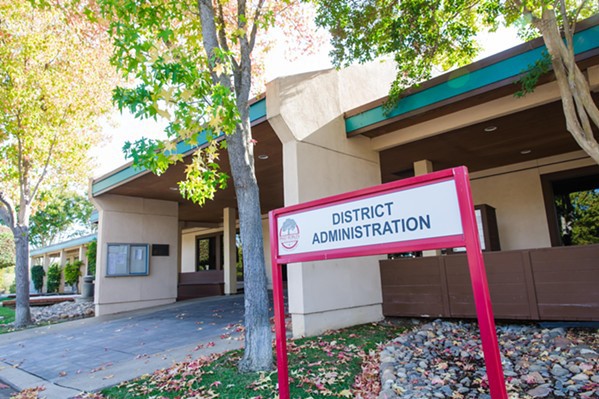[{
"name": "Newsletter Promo",
"id": "NewsletterPromo",
"class": "inlineCenter",
"insertPoint": "4",
"component": "15264767",
"requiredCountToDisplay": "0"
},{
"name": "Ad - Medium Rectangle CC01 - 300x250",
"id": "AdMediumRectangleCC01300x250",
"class": "inlineCenter",
"insertPoint": "8",
"component": "2963441",
"requiredCountToDisplay": "12"
},{
"name": "Ad - Medium Rectangle LC01 - 300x250",
"id": "AdMediumRectangleCC01300x250",
"class": "inlineCenter",
"insertPoint": "18",
"component": "2963441",
"requiredCountToDisplay": "22"
},{
"name": "Ad - Medium Rectangle LC09 - 300x250",
"id": "AdMediumRectangleLC09300x250",
"class": "inlineCenter",
"insertPoint": "28",
"component": "3252660",
"requiredCountToDisplay": "32"
}]
California is one of six states that still funds its schools based on average daily attendance numbers, but a bill currently making its way through the Legislature could change that.
Authored by State Sen. Anthony Portantino (D-Glendale), the legislation would provide supplemental funding to districts struggling with chronic absenteeism, as long as they can show the state that they're actively trying to combat it. After passing the Senate earlier this year, Senate Bill 830 is sitting in the Assembly Committee on Education.
The current system includes a built-in "financial incentive encouraging school and district staff to boost attendance, recognizing that students cannot learn if they do not attend school," according to a report from Policy Analysis for Higher Education. "Conversely, the system effectively withholds funding from school districts with higher absenteeism."
From 2020-21 to 2021-22, average daily attendance numbers in districts statewide dropped 5 percent due to COVID-19, said Jim Empey, the assistant superintendent of business for the Lucia Mar Unified School District.
According to district spokesperson Amy Jacobs, Lucia Mar's average daily attendance was at 96.5 percent in 2019-20, and by 2021-22, that number had dropped to 91.6 percent.
"More students were absent last year because of quarantine rules, whether or not they were actually ill," Empey told New Times via email. "We processed a lot of short-term independent study packets to help students learn when they had to stay home from school."
But students also had a hard time returning to class after a year-plus hiatus from campus.
Dana Holt, Paso Robles Joint Unified School District's safety supervisor/attendance officer, said that some students lacked the motivation to physically return to school after being able to connect to classes whenever they wanted to during distance learning.
"A lot of kids, from my experience, have not wanted to come back to [the] classroom," she told the Paso school board during a June 28 presentation on attendance. "I think COVID played a large part of that."
With an enrollment of about 6,620 students, roughly 1,500 or 23 percent of the Paso district has chronic or worse attendance issues. Chronically absent students (those who miss 10 percent or more of the school year) in fifth grade, Holt said, miss an average of 120 hours more instructional time than other students.
Chronically absent Hispanic students receive 131.5 fewer instructional hours than other Hispanic students in the district, and white students receive 138.9 fewer hours than other white students in the district, Holt said. She added that the district sent out 9,345 parent communications in 2021-22 school year regarding absences. They sent out 3,691 first letters, 2,087 second letters (if the student continues to miss school after the first letter), and 493 third letters.
"A very large number realized, 'Hey, we need to start going to school,'" Holt said. "That is evidence that those letters are working."
Student Services Director Tom Harrington told New Times that the district reaches out to families when it first starts to notice a student with attendance issues. They send letters, make phone calls, and try to provide support—whether that's within the school system or connecting families with community resources—in order to remove the barriers preventing a child from attending school.
"Some of our goals are to have kids reading by the third grade and be doing algebra by the ninth grade," Harrington told New Times. "And it's hard when they're not in school getting instruction."
The school district also loses out on funding when students aren't in school. Paso Chief Business Officer Brad Pawlowski said that if, hypothetically, the district is supposed to receive $10,000 per student from the state, but its average daily attendance is 96 percent, Paso will only receive $9,600 per student, he said.
Knowing this and COVID-19's impact on attendance in 2019-20 and 2020-21, the governor made some adjustments to how districts were supposed to calculate attendance numbers and report them to the state. School districts are usually funded based on the previous year's attendance, but they were able to use their attendance numbers for 2019-20 school year up to February for both this year and last year. Pawlowski described it as a "buffer."
There was a "huge concern that we were going to have this massive funding drop," Pawlowski said, if the state reverted districts back to the pre-COVID-19 funding formula. Instead, California is planning to allow districts to use a rolling three-year average of attendance for the 2022-23 school year.
"They have put things in place to help districts have a somewhat softer landing," Pawlowski said, adding that the state and federal governments have both offered pots of one-time money to help beef up programs such as those that help kids make up for learning lost during the pandemic and those that focus on social-emotional wellness and well-being. Both Paso and Lucia Mar have taken advantage of some of those funds.
"They've afforded us the tools that we know kids are going to need when they come back into the classroom," Pawlowski said. "You've got to be on campus to benefit from those programs or services, so that's why attendance is so important." Δ
Reach Editor Camillia Lanham at [email protected].
Latest in News
Readers also liked…
-

Coast Unified teachers upset over new position's salary and qualifications
Oct 20, 2022 -

SLO police identify alleged driver who hit and killed couple
Dec 22, 2022 -

When the levee breaks: Oceano residents, county officials walk a tightrope of regulations to manage Arroyo Grande Creek, which some say led to the levee's failure in January
May 18, 2023








